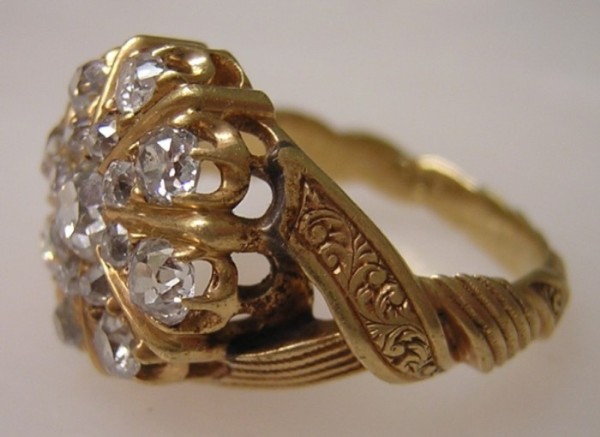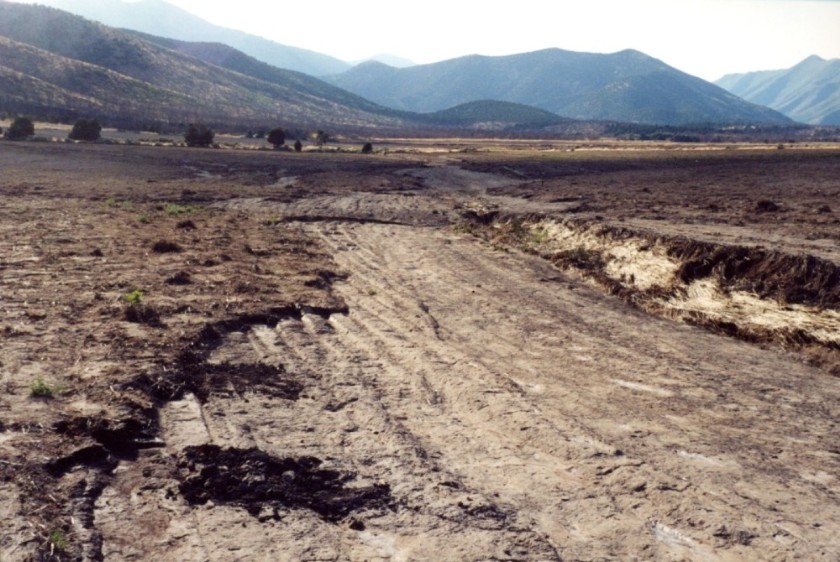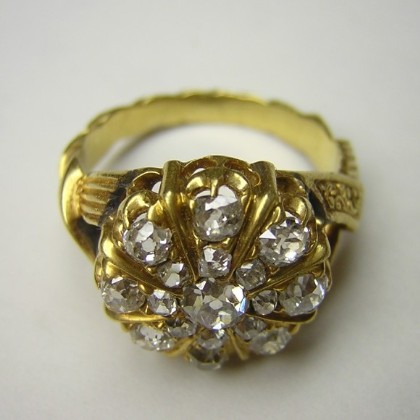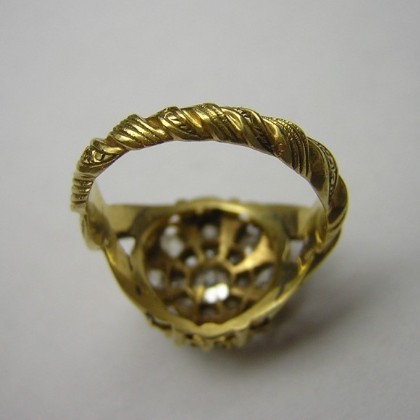Secrets of the Ring
“Those are not real diamonds, those are what we call foil-backs.” Those words, or similar ones, are what I normally first hear when I show my ring to a jeweler. I don’t really blame them for thinking that either, because it was my first thought also, when I first laid eyes on it.
My story goes back many years, but let me first tell it from the date the ring was found - July 11, 2001. The particular site that I was searching has been hunted hard for several years, even decades, and it’s been difficult to find anything at all lately. It’s been hunted hard with machines like XLT’s and CZ5’s, running in the all-metal mode, with sensitivities cranked to the max. It’s been hunted hard by tough, dedicated searchers, who are not afraid to dig junk for hours upon hours. A relic hunter really needs all the help he can get nowadays. With that said, a large mid-summer rainstorm came and hit the site, the type of storm that comes maybe once every fifty years or so, and it gave me the edge I needed. The water in some of the washes and ravines reached a depth of six feet or more, and the storm flooded houses in a small town five miles away. It was a real gully washer! Large amounts of topsoil were eroded from the plowed fields, leaving marks of the plow blade in the harder packed soil beneath. Those were the areas in which I was concentrating my search patterns. If there was anything left to be found, this is where it would be.
After two hours of searching I was starting to get discouraged. Signals were few and far between. I had found a few square nails and one tent grommet. I was thinking that I would be better off back at the ranch watching chickens. Then my XLT came upon a strange signal centered around zero on the “spectrum” display. Garbage? Probably. But years of experience have taught me to dig unusual garbage-type signals such as this. I dug a shovel full of dirt out of the ground and recovered two small square nails. I was still playing with some type of signal in the hole, and then I spotted what looked like a costume jewelry brooch, lying in the bottom of the hole! A closer inspection revealed that there was no patina on the stones; they looked like little wet ice cubes. The authenticity of the stones was still in question, however, there was no mistaking the gleam of high quality gold - this must be a genuine diamond ring!
One often ponders the historical importance of a find such as this. Where did it come from? Who did it belong to? When was it lost? Did it slip off a finger in the dark, or was it thrown away in a rage of jealousy? Was it desperately searched for in vain? The answer to most of those questions may never be known. Fortunately for me, I actually did know some of the history of this ring, and it made the find all the sweeter.
My mind started to wander, and I was transported back to a distant time and place, when life was vastly different than it is today. Exactly 144 years ago to the day, July 11, 1857, this ring, in all likelihood, was located very close to a place called Fort Leavenworth, in Kansas Territory. It’s exact whereabouts is uncertain at this point, but it was associated with a military campaign called the Utah Expedition. This military force consisting of some 2500 soldiers, under the command of Colonel Albert Sidney Johnston, was ordered towards Salt Lake City to deliver a new governor, and subdue a supposed Mormon rebellion. Brigham Young, Mormon proclaimed Prophet of God, and leader of the Mormons, forbid the army to enter the territory. Thus started the “Utah War.”
By November 3, 1857, it can be said with more certainty that this ring was located at the confluence of the Hams Fork River and the Blacks Fork River in the Utah Territory, presently known as the state of Wyoming. Colonel Johnston, accompanied by a forty-strong escort of the Second Dragoons, had just combined forces with the Fourth Artillery and the Fifth and Tenth Infantries, encamped near a place known as Camp Winfield. The Mormons were resisting the military invasion. They had burned the grass in front of the army for miles, and even destroyed a few military supply trains.
Following along with Johnston’s Army on its westward march from Camp Winfield, this ring was later at the “Camp of Death,” when temperatures dipped so low that some 500 starving animals froze to death, dozens still in the harness, some falling on tents. The army was in serious trouble, being caught in a mountain wilderness at the onslaught of a severe winter storm. The eyes of the whole world were now on this expedition!
Because of the unexpected Mormon resistance, and the adverse weather, Johnston’s Army was forced to spend the rough winter of 1857-1858 huddled between the recent burned-out ruins of Fort Bridger and Fort Supply, at a new place called Camp Scott. I try to imagine what the owner of this ring did there. Were there romantic evenings in a candle lit Sibley tent? Possibly. But more than likely it was a struggle all the way. Snow, wind, freezing temperatures, dwindling supplies, all the while facing an uncertain future. If only this ring could tell the story!
It is a certainty that this ring passed through the streets of deserted Salt Lake City on June 26, 1858. From sunrise to sunset the army made its triumphant march westward through the city, with regimental flags flying and the Tenth Infantry Band playing. The citizens had fled fifty miles to the south, to the eastern shores of Lake Utah, except for a few of Brigham’s heavily armed “Destroying Angels,” left behind to torch the city if the army molested any property. This was one of the most dramatic events that happened in the Utah Territory. This ring was there. This ring was a part of that historic event!
Shortly afterward, this ring was located on a rise threaded with a small stream. Here it rested quietly in the ground, motionless, for the next 143 years, as the raging events of history passed on.
Yes, I knew something about the history of this ring. The vision of the past slowly faded as I woke from my pondering. Returning to the present, I dug five more square nails from the exact same hole before all the signals disappeared.
So you see, I really don’t blame a jeweler for a low-ball first impression of my ring. The fact is, most jewelers I have run across are not prepared to deal with a ring of this age and antiquity. They look at me only in disbelief when I tell them it’s been in the ground for 143 years. They know nothing about the historical importance of the ring.
Skillfully crafted from 18-karat yellow gold, the ladies size-6 ring is crown set with a large mine-cut diamond in the center. Circling around this largest stone are eight additional stones, and circling around those are eight more. Seventeen mine-cut diamonds in all, forming a pattern like the spokes on a wheel. The gold supporting the diamonds is highly detailed, resembling a miniature crown of its own, and an engraving of two entwined ribbons encircles the entire band. These few words do not justly describe the beauty of the ring. There are no marks engraved on the inside of the band, and it shows little or no signs of being worn. As fate would have it, the ring was found in the Second Dragoon camp of Johnston’s Army.
With just a few meager clues that history has left us, is it possible to determine whom the original owner of the ring was? In the letters of Captain Jesse A. Gove, Tenth Infantry, Gove specifically states on October 20, 1857, that there are only two ladies at Camp Winfield. These two ladies are the wife of Colonel Edward R. S. Canby, Tenth Infantry, and the wife of Lieutenant William W. Burns, Fifth Infantry. Writing from Camp Scott, Gove indicates that Mrs. Elizabeth Cumming (wife of the new governor) arrives at that location on November 19, 1857. The wife of Lieutenant Samual S. Carroll, Tenth Infantry, arrives at Camp Scott on June 10, 1858. Besides Mrs. Cumming, Gove indicates that there were only three ladies in the expedition.
On June 3, 1858, Governor Cumming and family moved from Camp Scott to Salt Lake City, two weeks before the army started its advance. The letters of Mrs. Cumming support a Mrs. Canby and Mrs. Burns at Camp Scott. Mrs. Cumming writes that the ladies are isolated from each other, and they stay with their respective husband’s regiments. Mrs. Cumming writes nothing about Mrs. Carroll, or any other lady. However, she writes the following statement on July 5, 1858, nine days after the army passed through Salt Lake City: “Rode 18 miles to the camp to bid the four ladies goodbye. They leave for Cedar Valley, 22 miles farther from the city than they now are - too far to visit.” Who was this elusive fourth lady?
If you dig a little deeper into obscure, dusty old journals, you may find that there were indeed four ladies who passed through the “City of the Saints” that long ago day in June. You may find a Lieutenant Charles H. Tyler, of the Second Dragoons, and his recent bride, who accompanied Colonel Johnston in the fall of 1857. The Second Dragoon camp was located some distance away from the rest of the army, which isolated this lady from the others. My bet is, this ring belonged to the wife of young Charley Tyler - the former Miss Lizzie Wright.
Did this ring actually belong to Mrs. Charles H. Tyler? What were the circumstances of its loss? Additional research may reveal the answers to some of my questions. Until then, I’ll just be thankful for that good old summer rainstorm, that one-in-fifty year storm, that good old gully washer - it gave me the edge I needed!

.
Photo showing the location where the ring was found. View looking northwest towards the mouth of West Canyon.


